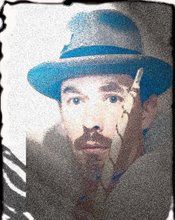
The Shamrock and the Spring Equinox.
As a symbol of St. Patrick’s Day on March 17th the shamrock has gained immense notoriety and popularity. It has come to represent the entire immensity of Irish Celtic culture, and a cause of cultural celebration. This is both a secular and religious occasion in remembrance of the death of the fifth century Christian Saint Patrick. Whilst the spiritual aspect of the feast may have been held for over a thousand years, the first secular day was only celebrated in March 17th 1752 in New York, by Irish troops serving in the British Army.
My investigations into the origins of this day led me to believe that this celebration was, in the pre-Christian Irish community a festival of the Vernal Equinox. Although there is no written evidence to support this theory I took into account several sources, including the very potent symbol of the shamrock itself. The first fragment of Pagan Irish lore that I considered was a ‘God of the Shamrock’ mentioned in a medieval tale called ‘The Settling of the Manor of Tara.’ Tara’ by the name of Trefuilngid Treeochair (Triple Bearer of The Triple Key), the one who causes the sun to rise and set and who stands at this point midway. A glorious God of Spring not unlike the figure of Dionysis, who brings as yet unripe fruits of green, and aids in the divisions and organization of the land. The name ‘Tree-foil’ means three-leaves and is connected to the characteristic form of the shamrock.
It is reputed that at Armagh St. Patrick explained the doctrine of the Trinity, the Father, Son and Holy Ghost through the example of the three-leafed shamrock:
Good St. Patrick traveled far, to teach God's Holy Word
And when he came to Erin's sod, a wondrous thing occurred
He plucked a shamrock from the earth and held it in His hand
To symbolize the Trinity that all might understand
The first leaf for the Father
And the second for the Son
The third leaf for the Holy Spirit
All three of them in one.
However, Patrick was only too well versed in Irish Pagan mythology and beliefs, and was prepared to adapt and employ them within a Christian context to win bodies and souls to the new religion. It may be seen that often he presented himself as a Druid, practicing a new form of magic to attract followers and disciples.
The shamrock was already a sacred plant in Pagan Irish culture. Known as the seanrog or ‘summer plant’ it represented several triads and trinities but most notably the three moral qualities of love, courage and wit. It was a symbol of the Goddess Brighid as virgin, mother and crone,together with her three spiritual facets; the inspiration of poetry, craft of making, and the success of healing. Most importantly it was a perceived as a Celtic solar wheel, perhaps linking the vernal and autumnal equinoxes with the high summer solstice, or more realistically the festival of Imbolc, the spring equinox and Beltaine. This native spiritual desire to achieve balance and harmony from nature is beautifully captured in a poem by Frederick Casey, the Bard of the OBOD:
Pick a clover and make a wish
Kiss each leaf and let the wind take it out of sight
And with the coming of the balance of day and night
May the Shamrock's luck swim to you like a fish
Back from the waters of the returning tide
The stream of Spring is filling up
Open our soul to fill it like a cup
With the energy that winter tried to hide
So, whilst we can never claim that St. Patrick’s day was originally celebrated as the Spring Equinox we can claim the humble shamrock as a Celtic symbol of spring. It gives us a sense of inspiration within history and tradition, a positive reminder of a green season and the coming summer, and most recently has been discovered as a healing agent for cancer. It is traditionally included in the bouquet of an Irish bride for good luck, and part of an older ceremony called ‘the drowning’ in which the plant is placed into a toasting cup, when the toast is proposed, honored and drank the shamrock is removed from the bottom of the glass and thrown over the left shoulder.
Perhaps the most ancient and symbolic representation, as well as the most debatable in one of the stones at Newgrange, dating back to 5000 BCE, inscribed with three spiraling leaves which closely resemble the form of a shamrock!
But I leave you with a small acrostic poem by Joseph Rohrbach which seems to sum up the hidden mysteries and values of the shamrock…
Simple little plant
Head held high
As if a promised
Magic lies within
Randomly bestowed
Over the finder
Carrying a sweet
Kiss of luck
Go mbeannai Dia duit (May God Bless You)
David O’Draoi
St. Patrick’s Day:
http://www.history.com/minisite.do?content_type=Minisite_Generic&content_type_id=851&display_order=2&sub_display_order=1&mini_id=1082
Dr. T. Umbrello of UCC Biology Dept: The Shamrock:
http://faculty.ucc.edu/biology-ombrello/POW/shamrock.htm
The Pagan Trinity:
http://www.sabbatarian.com/Paganism/HecateTrinity.html
Triskelle: St. Patrick and The Shamrock:
http://www.triskelle.eu/history/saintpatrickshamrock.php?index=060.040.010.010
The Shamrock, And Other Sacred Plants. Irish Druids… by James Bonwick.
http://www.sacred-texts.com/pag/idr/idr26.htm
Christine O'Keefe, Trefuilngid Tre-Ochair:
http://www.tartanplace.com/faery/gods/trefuilgnid.html
Alban Eilir – The Vernal Equinox:
http://www.druidry.org/obod/festivals/eilir.html
Ireland Newsletter, June 2001:
http://www.ireland-information.com/jun01.htm
Labyrinth Ireland:
http://www.labyrinthireland.com/irishlabyrinths.html
BBC: The Truth Behind The Shamrock:
http://news.bbc.co.uk/1/hi/uk/3519116.stm
Poem of the Day, Joseph Rohrbach:
http://www.mindspring.com/~jarzap/potd.html



No comments:
Post a Comment